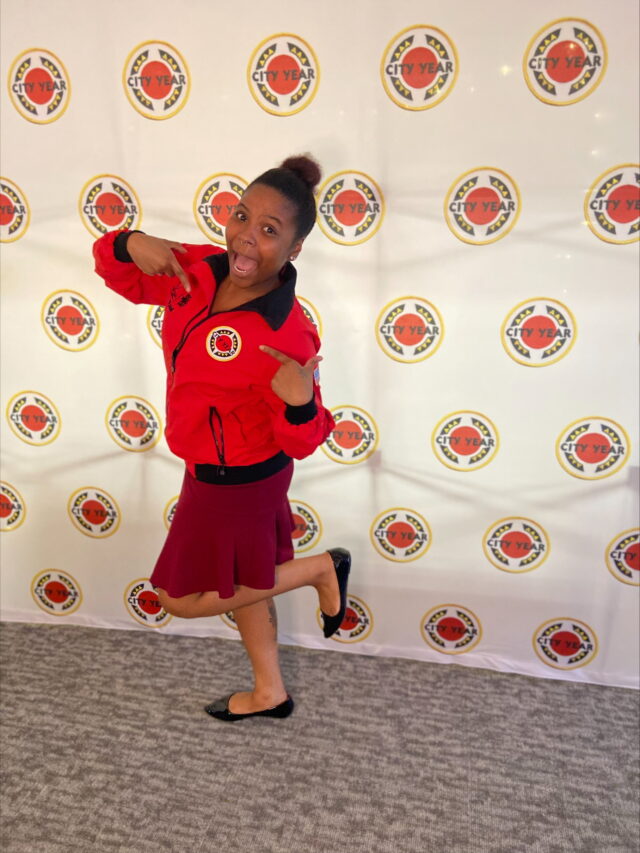Recent City Year Alum Aspires to Support Foster Youth
Jazz Solomon, City Year Orlando ’24, served as an AmeriCorps member for two years, the second as a team leader, when she helped support school-based teams of student success coaches as they tutored and mentored students.
Jazz is passionate about helping foster youth who are “aging out” of the system to transition to adulthood and recently accepted a job helping youth who are facing homelessness. Drawing from her own experience spending time in foster care, Jazz plans to open her own nonprofit, to provide critical supports to foster youth and help them succeed in the real world.
Jazz shares her journey as a youth advocate, student success coach, and aspiring nonprofit leader, and how each step along the path helped her along the way.

Finding purpose: A desire to serve youth
I found City Year by accident. After I graduated college in 2023, I was looking for jobs in Florida and Texas and I came across City Year. I didn’t really know exactly what it was, but I knew that I would be supporting youth, which has always been my goal. I ended up starting my service year in October 2023 in Orlando, Florida.
Serving youth has always been important to me and has always been something I wanted to commit my career to. I’ve actually been working with youth since I was a youth myself.
When I was 16, I got involved in nonprofit work with an organization called SaySo, Strong Able Youth Speaking Out. The organization is a North Carolina statewide association of youth ages 14-24 who have been in the out-of-home care system. I learned about the organization from my foster mom, and I attended their annual anniversary event. And I was just amazed.
I remember thinking “Oh my gosh, there are youth speaking out for each other.” I felt so much power in the room, so much livelihood and freedom.
From there, I wound up applying to be on their board of directors, their Youth Advisory Council. In that role, you speak out in your specific region, vote, reach out to Congress, and more. I served as secretary on the board for two years and am still involved to this day.
That experience showed me what I wanted to do in life and how I could take steps to get there. I always feel like I have SaySo’s support and if I need anything, I could always go home to SaySo – it’s a little family. My experience with SaySo led me to City Year.
The reason that I serve is to give youth who feel like their voice doesn’t matter or who think their voice isn’t important enough an opportunity to be heard. I want to show them that their voice is important and it needs to be heard.
They are the future and if they’re not speaking out now, I want to show them how to do so. To really just give them their voices back.
Growing up in foster care
I was in foster care myself; I was entered into the foster care system at 12, and I stayed in there until I aged out.
That experience really showed me what I wanted to do. Up until that point, I wanted to be a lawyer to work with juveniles and delinquents. I wanted to help people that I could relate to in that way.
But when I got into foster care, I saw how broken the system was. There are resources there, don’t get me wrong, but a lot of youth don’t know about the resources because they’re not presented to them. So, when they turn 18, a lot of them don’t know where to go or what to do next. Some states do offer a program where if you go to college or start working, they offer money until you are 21.
Did you know there were 390,000 youth in foster care in the United States in 2021? Each year, more than 20,000 “age out” of the foster care system when they reach the age of emancipation, which is usually between ages 18-21, depending on the state. These young people lose access to services and supports they received within the system and lack resources, family stability, and a safety net as they have to navigate adulthood. Research shows that youth who age out of foster care are more likely to experience negative outcomes such as economic hardship, homelessness, health issues, and substance abuse than their peers.
But when you age out of foster care, no one tells you things like “hey, you need an ID,” or “This is how you keep up your credit score,” things like that. So, when I was 19 or 20, I started thinking about what I could do to better the system other than what I was already doing, which was advocating.
What more could I do? And that’s what made me want to open my own nonprofit, a transitional living program. Not just a place to stay, but a place to stay and be provided with the resources you need for six months, a year, or more. I just want to open a door for them to not feel so alone or unprepared when they get into the real world. So, my goal was set.
Did you know that City Year alums continue to lead and serve across a broad range of professions after their service year (or two) is over? Learn more about the impact of City Year alumni on education, the nonprofit sector, and more.
Learning from the students we serve
My first year of service I started mid-year, so I was kind of thrown into the job. It was rough. The only thing that I can say is like during that first month, it was my students that kept me going.
I came into work every day and they would joke with me. They kept telling me that they felt like they were actually learning from me, which was nice to hear. When my Impact Manager came back from maternity leave, she was surprised to hear that I just came in and grabbed the opportunity and went with it. She told me that I had a skill that not a lot of people naturally have.

And I realized that this is just what I love to do. So, I ended up applying to be a Team Leader. I really decided to be a Team Leader because my students were in seventh grade, and I really wanted to see them continue to eighth. I wanted to see that full circle. My primary motivation is my students – they keep me going.
City Year has taught me a lot, especially when it comes to being in a position of some sort of power and leadership. Also, I have learned the importance of taking time to take care of yourself. City year has helped me to realize how precious time is because, you know, working these 10-to-12-hour shifts, you realize how little time you have left in the day. And how you should take advantage of even the smallest amount of time.
Helping foster youth to succeed
When I think about my future organization, I imagine it as kind of a group home, where it is set up to look like a college campus, where each home has different levels of need depending on your situation. I want to be able to host many people, and one day I hope to make it nationally available across the country. Who knows where it could go from there, but I am trying to take it step by step.
I’ve learned so much by working at different nonprofits and seeing different structures. It has helped paint a better picture for me of what I want my nonprofit to look like. Overall, I want people who participate in my program to stay in the program until they feel like they have the resources and support they need to thrive in the real world. I want them to know that they can always come back, that life happens. I want to create a home, a welcoming space. I want people to take what they need.
I actually was just recently offered a job with the Tampa Hillsborough Homeless Initiative where I will be a youth contract manager, so I’ll be the liaison between the Youth Advisory Board and the other departments. I’m really excited about it and excited to continue working with youth. I’ve been introduced to so many other organizations that have similar frameworks and missions when it comes to being youth-led.
For example, back in 2023 I was offered an opportunity to be a delegate with NFYI – National Foster Youth Initiative, an organization that speaks out about needed changes for foster youth. It’s a 10-month program where every month we do professional development sessions; we meet with and shadow Members of Congress. It was through that opportunity that I was actually introduced to an organization that I have a part time role with on the Youth Policy Board for, A Way Home America, another organization committed to ending housing injustice and homelessness.
I’m big on talking to people, networking, and connecting. I’ve been really trying to instill that into my City Year team this year, people really can get you so far. Networking is kind of the key to getting where you want to be. So, through City Year and all the opportunities I’ve had, I’m building a network for my future.
Related stories
City Year Philadelphia alum Anthony Copeman, a certified financial educator who focuses on helping millennials manage their financial health, grew...
Read more about Financial success on a stipendThis story first ran in 2023 and has been updated. A recently issued report from the Partnership for Student Success...
Read more about Learn about a partnership to support studentsWhen you’re living on an AmeriCorps stipend, every penny counts. To help you make the most of your bi-weekly stipend,...
Read more about Four ways to stretch your AmeriCorps stipendHere are three tips for mentors of all ages who seek to connect with and promote children's holistic growth by...
Read more about Three steps to forge positive relationships with students














